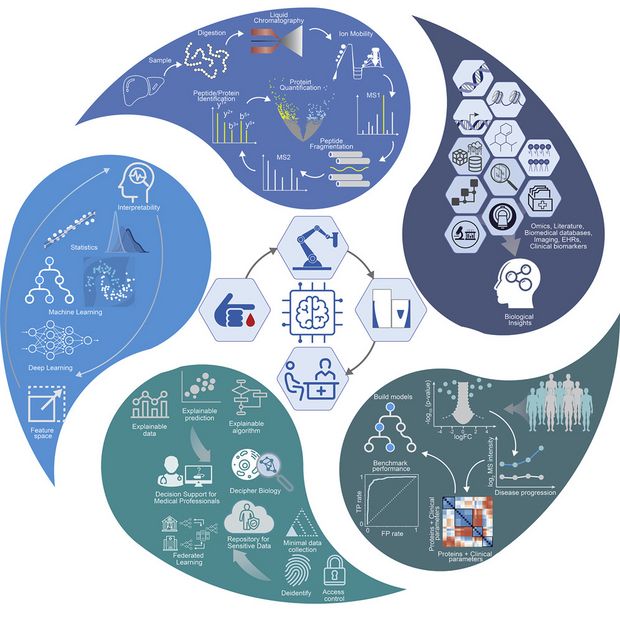Innovative techniques for research and diagnostics
To advance the development of new diagnostic approaches and the identification of disease mechanisms in ophthalmology, we have established a special bioanalytical lab with state-of-the-art mass mass spectrometry equipment, expertise in proteomics, metabolomics, bioinformatics, and systems medicine. By deeply analyzing retinal protein networks, we aim to uncover molecular mechanisms in photoreceptors, in the pathology of retinal diseases, and to find diagnostic biomarkers. This is complemented by cutting-edge imaging techniques, including STED- and Electron-Microscopy, and the development of adaptive optics, to visualize cellular structures in the retina. We participate in the German National Cohort study (NAKO), coordinating the Competence Unit Retina, and also habour the Helmut Ecker Eye Tissue Resource (HEETR), enabling us to validate molecular findings in patient samples and tissue.
Current Projects
Mathematical model of protein dynamics and transport in the photoreceptor
The transport of proteins during light and dark adaptation in photoreceptors to date has been described for only a few proteins, such as transducin, arrestin and recoverin. In retinal photoreceptors, light exposure results in the massive translocation of these proteins between inner and outer segment. As a global quantitative description of the overall protein dynamics was missing so far, we aimed at a detailed quantitative analysis of light/dark-regulated proteins in rod outer segments. This enables us to make predictions on the effects of gene knockouts and study the consequences of mutations in a broader context to facilitate projects for diagnostics and therapy of retinal diseases.
The German National Cohort (NAKO): Competence Unit Retina
Within the German National Cohort study (NAKO) we have developed a tool set for the automated analysis of retinal fundus pictures, including tools to analyse the retinal vasculature and the detection of vessel tortuosity. In addition, we are developing algorithms to detect exudates and drusen, a hallmark of age-related macular degeneration (AMD). The tools allow us to analyse large data sets and to link ophthalmologic data to other indication fields. In particular, we aim to investigate whether early detection of retinal vascular anomalies can help to predict other systemic diseases such as diabetes, neurodegenerative or cardiovascular diseases. www.nako.de
Dynamic adaptive microscopy for label-free multi-parametric imaging in biology and medicine (EU)
The EU-funded DynAMic project aims at deeper in vivo imaging thanks to improved optical microscopy techniques. Although optical microscopy has been extensively used in medical imaging, its use in in vivo studies presents a number of challenges. First, the diffusing nature of light propagation in tissues limits in vivo microscopy to superficial depths. Second, the invasive fluorescent tags allow monitoring of only 1-5 events; this performance is far below the targets set by functional genomics and proteomics. The DynAMic project will address these two fundamental limitations. Use of wavefront-shaping adaptive optics will improve the performance of optical systems, while inversion light diffusion techniques will help it reach 10 times deeper into tissue. In addition, advanced image formation techniques will radically improve label-free high-contrast imaging. These new techniques will be tested in ophthalmic imaging. https://cordis.europa.eu/project/id/863203
Technology to investigate Retinal Degenerations
Our state-of-the-art mass spectrometry equipment, expertise in the proteomic, metabolomic and system medicine fields enables tailored solutions and experimental design to address specific scientific challenges in elucidating mechanisms of Retinal Degenerations. We specifically use interactomics to define protein interaction networks and bioinformatics to perform complex analyses of large omics-datasets. These techniques allow us to identify signalling pathways and key factors involved in retinal disease mechanisms and define potential targets to develop therapeutical strategies.
Helmut Ecker Eye Tissue Resource (HEETR)
The Helmut Ecker Eye Tissue Resource (HEETR) is one of Europe’s largest human eye tissue collections containing eye tissues from >1,200 donors. Originally founded in 2015 in Manchester by Prof. Paul Bishop and Prof. Simon Clark, the eye tissue has been transferred to the University Hospital Tübingen under the custodianship of Prof. Clark in December 2020. The biobank contains human eye tissue from post-mortem eyes donated with consent for corneal transplantation and subsequent research use, including macula and peripheral biopsies stored in cryo-preservative. Each donor eye was phenotyped for retinal dystrophies and also genotyped for risk haplotypes associated with the common blinding disease, age-related macular degeneration (AMD). This resource has already contributed to major studies in AMD and other ocular diseases by supplying consented, anonymous, highly characterised human eye tissues to research groups around the world.




